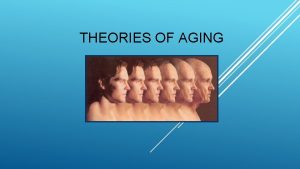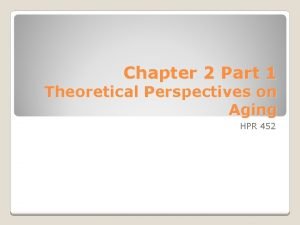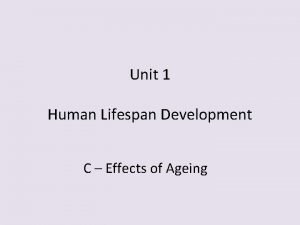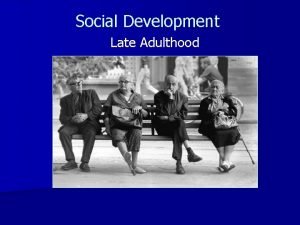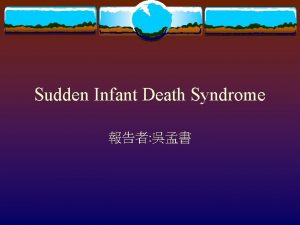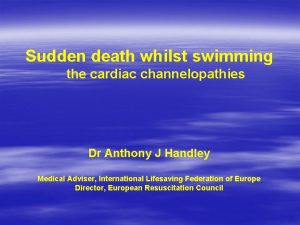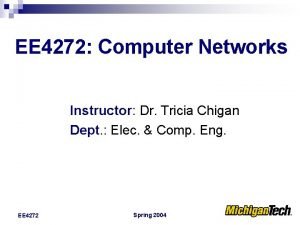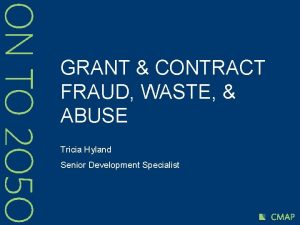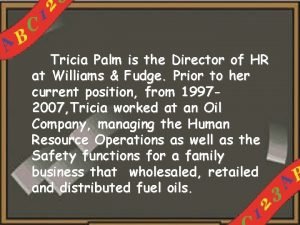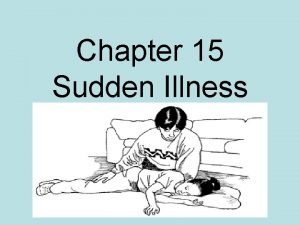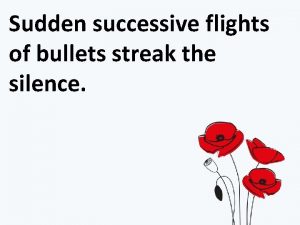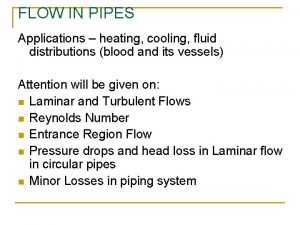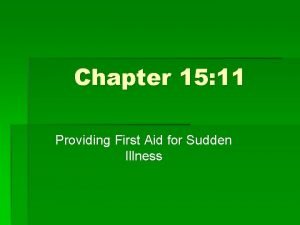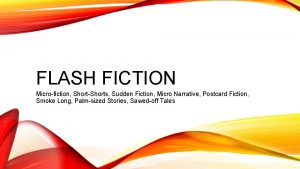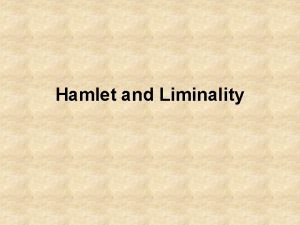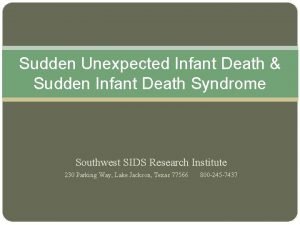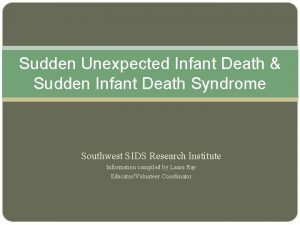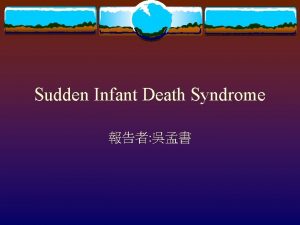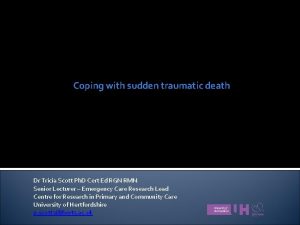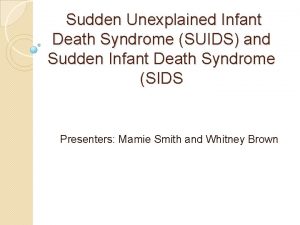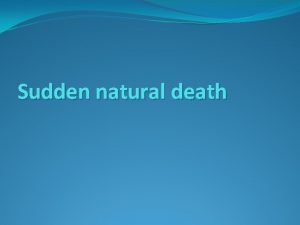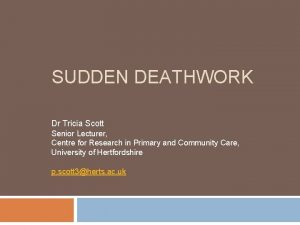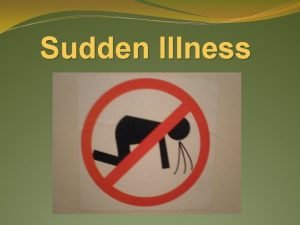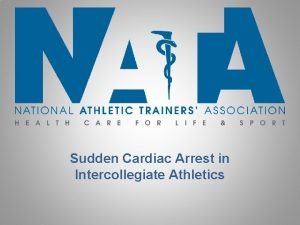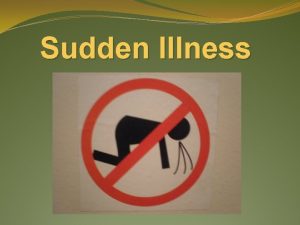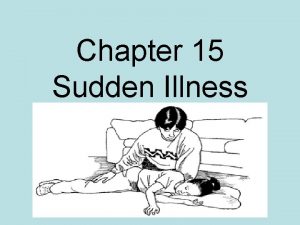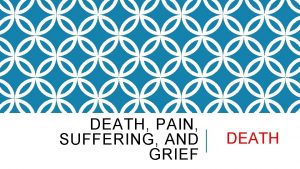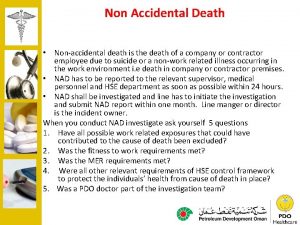Sudden death liminality dehumanisation and disengagement Dr Tricia






























- Slides: 30

Sudden death liminality: dehumanisation and disengagement Dr Tricia Scott Centre for Research in Primary and Community Care University of Hertfordshire p. scott 3@herts. ac. uk

“We imagine ourselves surrounded by loving friends, the room filled with serene quietude that comes from nothing more to say, all business finished; our eyes shining with love and with a whisper of profound wisdom as to the transiency of life, we settle back into the pillow, the last breath escaping like a vast ‘Ahh!’ as we depart gently into the light. ” (Levine, 1988 p 8)

The A&E sudden death scenario is stripped of ‘good death’ characteristics. Reduced to a socially rationed attempt to resuscitate, in the absence of loving friends involving a barrage of invasive procedures and measurements conducted within a resuscitation specific frame. (Timmermans, 1999)

Purpose of the paper To understand, the uniquely held beliefs and values of emergency personnel involved in sudden death work and specifically, the process of disengagement in the space between life and death.

Rationale Provide a substantive theory of sudden death work Illuminate problems of dealing with sudden death Enhance interprofessional working relationships Provide a catalyst to inform change in service provision

Literature review Death trajectories (Timmermans 1999) Status passage (Van Gennep 1960; Glaser and Strauss 1971) Death work (Goffman 1959; Prior 1987) Embodiment (Scott and Morgan 1993) The body ‘polluting’ (Shilling 1997) Dramaturgy (Simmel 1950; Bradbury 1990) Dirty work (Hughes 1981) Emotional labour (Hochschild 1983) Binary oppositions (Howarth, Hockey and Hallam) Sudden death incapacitation (Wright 1991)

Sudden death work by emergency personnel crosses social worlds between life and death During this critical period rites of passage exist: ‘rites de separation’ (pre-liminal phase) ‘rites de transition’ (liminal phase) ‘rites de incorporation’ (post-liminal phase) Van Gennep (1960)

Transition of the patient ‘betwixt and between’ alive and dead (Turner, 1967) Creates a critical space within which emergency personnel disengage from the deceased Temporal in that it takes time to create emotional and spatial distance from the once live person

Disengagement pathway Comprises an awareness of a cluster of elements: recognition that the patient is dead; recognition that nothing more can be done for the patient recognition that the death processing industry should manage the aftermath of the death (Sudnow, 1957)

Generally managed in a linear fashion Uni-directional path from which patients do not return Specific body handling procedures create humanising forces which may interfere with the linear path towards disengagement, reminding the practitioner of the person the deceased once was Stripping the body, identification, body wrapping

Method Chicago tradition Grounded theory Constant comparative method Theoretical saturation Triangulation

Location and sites 3 A&E departments in the North of England Department 1 – trauma centre Departments 2 and 3 – acute general hospitals

Ethics Approval Research Ethics Committee and research governance approval was obtained at 3 Acute NHS Hospital Trusts Chief Superintendent of the Traffic Division Ambulance Service

Data collection Ethnography 9 focus groups 45 -90 minutes duration 3 groups of paramedics 3 groups of A&E nurses 3 groups traffic officers Informant narratives and field notes

Data analysis Researcher transcription Coded within a non-numerical unstructured data indexing, searching and theorising package (NUDIST NVivo)

Presentation of results Geertz’s (1975) ‘thick description’ values the highly developed, multisensitivities of the author, the richness and subtlety of the observation, awareness of contextuality, and command of expressive language.

Rhetorical style Schutzian ‘relevances’ involve the common-sense interpretation of the social world The social scientist should abandon, the scientific attitude to engage with the social scene

Themes Role resignation routinisation, obstruction Legitimation rhetoric age, mode of death Emotionality humour, coping, annoyance, exhaustion Liminality dehumanisation, disengagement, binary opposites, ‘rites of passage’ Spiritual relevances Belief and transcendence, nihilism and nothingness

Objectification “It’s another body to go through ATLS (Advanced Trauma Life Support) protocol” (NC paragraph 246) “You wouldn’t recognise it. I only sort of look at the mouth or…Yeah. I’d know this epiglottis anywhere!” (PC paragraph 574) “I would open the mouth (gesture). You don’t see the mouth, you don’t see the face” (P paragraph 581)

“You know, when you’re in somebody’s house and you’re doing a resus and they die and you see all these pictures of people that they love. The thing is you don’t even notice that. You don’t see them. You don’t notice them” (P paragraph 593)

“All you do is your work and you’ve got your protocol in your mind and things are changing all the time and you look at your monitor and something different is on it and you redo a protocol and it just keeps going like that all the time” (PC paragraph 602)

Recognition as dead “I must admit I still talk to the person. I can’t do it silently, I’ve still got to tell them what I’m doing. It sounds really silly but I’ve got to, I mean they haven’t been dead for hours, they’ve just gone that minute…I’ve still got to talk to that patient and treat him like he’s still alive” (NB paragraph 436)

“And you’re not just wrapping them up like a piece of meat, ‘cos that’s what it sometimes seems like. It’s a person who maybe not more than two hours ago was actually walking around” (NC paragraph 323)

“Sometimes at the point of contact with it (body) you don’t look at it as a person, you know, you don’t think of the person who’s standing or running about and talking, its just like something that isn’t a person at all” (TPC paragraph 243)

Dehumanisation “I find that horrible, wrapping them up, I think its awful. I’m all right till I put the cover the head, they’re like a Christmas parcel, its just horrible that bit, I don’t like that. It would be all right if you left the head exposed, but as soon as you put the cover its just like a figure isn’t it? ” (NB paragraph 412)

Humanisation “But the man who collapsed had all these packages of money identified for his grandchildren for Christmas, it was Christmas week, and he’s gone out and he’s got his pension…” (NA paragraph 281)

Analogy “I wouldn’t want to let go of my baby with having a nursing background and the knowledge of them going in the fridge, it would just tear me in two…I think myself grateful because I don’t think I could sleep knowing where my child was” (NA paragraph 428)

Conclusion Provides a substantive theory of sudden death work in the emergency care trajectory Much sudden death work sits in the non-accountable range of activity Internal consistency provided a relatively accurate rendition of events and discussions Useful to position myself at the edge of my society operating within and without

Conclusion Rich detail of ‘happenings’ were revealed enabling procedural comparison Ethnography produced a ‘warts and all’ account Triangulation reduced personal bias from a single researcher, single method, single theory study Suggestions for procedural change related to e. g. baby clothes and, the mortuary sheet, handing over property

Thank you
 Age stratification
Age stratification Armored-defended personality
Armored-defended personality Disengagment theory
Disengagment theory Social development in late adulthood
Social development in late adulthood Sudden oak death map
Sudden oak death map Sudden oak death map
Sudden oak death map What is sudden infant death syndrome
What is sudden infant death syndrome Sudden death proc
Sudden death proc Dr tricia holmquist
Dr tricia holmquist Tricia chigan
Tricia chigan Lam tracia
Lam tracia Tricia cooney
Tricia cooney Tricia migliazzo
Tricia migliazzo Farienhight
Farienhight Tricia geraghty
Tricia geraghty Tricia roddy maryland medicaid
Tricia roddy maryland medicaid Tricia hyland
Tricia hyland Tricia meaning in bible
Tricia meaning in bible Tricia chigan
Tricia chigan Difference between somatic and cellular death
Difference between somatic and cellular death 4 examples of sudden illness
4 examples of sudden illness English 9 vocabulary unit 1
English 9 vocabulary unit 1 Sudden bullets
Sudden bullets Head loss formula for sudden contraction
Head loss formula for sudden contraction Head loss formula for turbulent flow
Head loss formula for turbulent flow 17:7 providing first aid for heat exposure
17:7 providing first aid for heat exposure Unit 15:11 providing first aid for sudden illness
Unit 15:11 providing first aid for sudden illness The valve closure in a pipe is said to be gradual when
The valve closure in a pipe is said to be gradual when The sudden release of energy stored in rocks causes a(n)
The sudden release of energy stored in rocks causes a(n) Sudden fiction meaning
Sudden fiction meaning Yas 35 dante gibi
Yas 35 dante gibi
